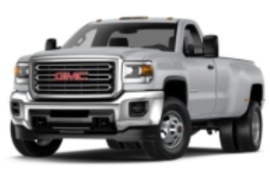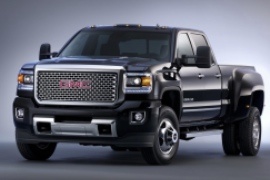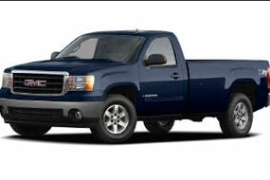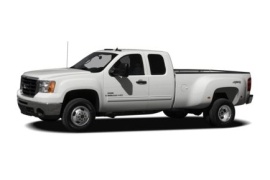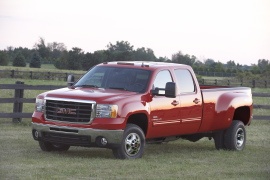GMC Sierra 3500HD Models/Series Timeline, Specifications & Photos
First production year: 2008
Engines: Gasoline, Diesel
Body style: Truck
GMC introduced the fourth generation of the Sierra pickup truck in December 2012, and the new vehicle came with a completely new exterior design, chassis, and drivetrains. Customers could get it with a two-door Regular Cab version, fit mostly for work.
While its Crew Cab sibling was a mix of everything, being able to work all day long and carry a family of five with a big trailer attached at the back during weekends, the Regular Cab was mainly a regular workhorse with a cabin where there was room just for maximum three occupants, seated abreast on one row.
Thanks to the new design, the 3500HD Crew Cab didn’t look like a regular workhorse anymore. Its front fascia showed a bold, commanding look on the road. The redesigned headlights were no longer split into two halves by a horizontal line as on its predecessor and featured corner-mounted turn signals. In addition, depending on the trim level and options, the massive grille, covered with a chicken-wire style mesh, was available with a chromed finish. Owners could order the pickup with a set of fog lamps mounted on the outer sides of the lower bumper and with a pair of towing hooks. From its profile, the Sierra retained one of its best-known design elements, the angular cuts for the wheel arches. Behind the two-door Regular Cab version of the Sierra 3500HD offered the option of either a bed or a flatbed for various applications. Moreover, GMC delivered the Sierra 3500HD as a chassis cab for additional aftermarket equipment. The automaker installed wider quarter panels for versions fitted with dual wheels at the back.
The base version of the Sierra 3500HD Regular Cab was offered with the Work Truck trim level, which featured a bench seat for three at the front, with a fold-down center armrest. When the middle seat was not needed, it was lowered to provide additional comfort and a pair of cup holders. The driver fronted an instrument cluster filled with two large dials for the speedometer and tachometer, plus four other smaller gauges for various information. In addition, GMC installed a TFT display for other information provided by the vehicle’s onboard computer. The gear lever for the Allison six-speed automatic gearbox was mounted on the steering column. Upper trim levels featured two individual seats, better upholstery, and even an infotainment unit with a touchscreen mounted on the upper section of the center stack.
GMC built the Sierra 3500HD on a sturdy ladder-frame chassis fitted with front independent suspension and an axle in the back. Depending on the engine and version, the pickup was available with either rear or all-wheel-drive systems, with a low-range gear for the transfer case. The 3500HD could also pull 19,000 lbs. (8,618 kg) trailer on the hitch or 23,200 lbs. (10,523 kg) on a fifth-wheel system.
In late 2012, GMC unveiled the fourth generation of the Sierra, relaunching competition on the heavy-duty pickup truck in the American markets. Moreover, the automaker made the launch in Detroit to further emphasize the importance of this workhorse in the industry.
Big and bold might be considered an understatement for the GMC Sierra 3500HD Crew Cab. It was a vehicle capable enough to take a team of workers to the top of the mountain and back, with a trailer attached in the back. Of course, the same vehicle could also pull a full-size camper behind, with the whole family onboard. GMC knew its customers and knew that they’d do both things, and that’s why it didn’t cut the spending when it made the vehicle and fitted it with all the necessary features and amenities needed for both situations. To get their attention, the automaker struggled and redesigned the cab design, strengthened the chassis, and made the interior richer, depending on the grade.
At the front, the massive grille was adorned by a chicken-wire mesh that sported the three-letter name of the automaker. It was adorned by a chromed surrounding and flanked by big, rectangular headlights. Unlike its predecessor, the 2014 Sierra didn’t feature a split line between the headlamps and the blinkers, and all of these were under the same piece of glass. The bumper sported round fog lamps on the sides, while the middle section was occupied by an underbody shield with two cut-outs for towing hooks. From its profile, the wide front fenders featured angled cut-outs for the wheel arches at the front, while at the back, the automaker offered the option for a dual wheel system to improve the towing capacity. In addition, next to the tailgate, GMC installed steps cut into the bumper for easier access to the bed.
Inside, the front seats of the Crew Cab version were wide and comfortable, separated by a wide center console where GMC installed a pair of cup holders and an open storage area fitted with USB ports. On the center stack, depending on the trim level and options, the automaker placed a color display for the infotainment system and the controls for the HVAC system. The driver fronted an unusual instrument cluster for a heavy-duty vehicle. Not only did it show the big dials for the speedometer and tachometer and four other smaller gauges for various information, but it also featured a TFT display that revealed other information about the vehicle from the car’s onboard computer. As expected, the lever for the automatic transmission sat behind the steering wheel. In the back, the wide bench was profiled for two but featured three seat belts.
GMC built the Sierra 3500HD on a sturdy ladder-frame chassis fitted with front independent suspension and an axle in the back. Depending on the engine and version, the pickup was available with either rear or all-wheel-drive systems, with a low-range gear for the transfer case. The 3500HD could also pull 19,000 lbs. (8,618 kg) trailer on the hitch or 23,200 lbs. (10,523 kg) on a fifth-wheel system.
GMC focused on hard-working vehicles such as the one-ton pickup truck, named Sierra 3500 HD (Heavy-Duty), and managed to be recognized as one of the best-in-class vehicles.
The pickup-trucks have become more and more luxurious and focused on passengers' comfort. But there was a select range of vehicles that offered more than just convenience. They were designed to carry heavy loads, pull trailers with equipment, and help the owner put bread and butter on the table. Unlike its siblings with four doors, the regular-cab version was designed mostly for work.
GM built the 3500 HD version for work, and it showed it. Its front fascia was tall, fitted with big squared headlights and corner-mounted turn-signals. Unusually for its class, the vehicle was available with a different pair of headlights with dual, horizontal lamps separated by a horizontal slat. Depending on the trim option, the front bumper was black, body-colored, or chromed. The Regular cab offered just two doors and a bench in the front, or individual seats depending on the trim level and options. GMC offered the Sierra with a choice of beds in the back or with a bare chassis.
Inside, GMC installed either a bench for three or two individual seats, depending on the trim levels. The WT (Work Truck – base model) featured rugged vinyl floor mats and stain-proof upholstery. The SLT, top trim-level, offered a higher comfort level with individual seats, wood-trims, and a sat-nav system.
GMC claimed that the most demanded version was the diesel version with its 6.6-liter Duramax unit that came with enough torque to pull a house and, thanks to the engine braking system, it saved the brake pads. All engine versions sent their power to the rear or all four wheels.
After a century of experience in building hard-working vehicles, GMC can claim a top spot in the full-size heavy-duty pickup trucks, and the 3500HD Extended Cab was proof.
The pickup-trucks have become more and more luxurious and focused on passengers' comfort. But there was a select range of vehicles that offered more than just convenience. They were designed to carry heavy loads, pull trailers with equipment, and help the owner put bread and butter on the table. Unlike its siblings with four doors, the regular-cab version was designed mostly for work, while the Extended Cabs were the middle road where a small team of five could travel short distances for a job.
GM built the 3500HD version for work, and it showed it. Its front fascia was tall, fitted with big squared headlights and corner-mounted turn-signals. Depending on the trim option, the front bumper was black, body-colored, or chromed. The Sierra 3500HD Extended cab offered two doors at the front and a set of rear-hinged ones in the back. Like its Regular Cab version, it featured a choice of short or long beds.
Inside, GMC installed either a bench for three or two individual seats, depending on the trim levels. The WT (Work Truck – base model) featured rugged vinyl floor mats and stain-proof upholstery. The SLT, top trim-level, offered a higher comfort level with individual seats, wood-trims, and a sat-nav system. In the back, the carmaker placed a bench for up to three occupants.
GMC claimed that the most demanded version was the diesel version with its 6.6-liter Duramax unit that came with enough torque to pull a house and, thanks to the engine braking system, it saved the brake pads. All engine versions sent their power to the rear or all four wheels.
GMC introduced a new generation of heavy-duty pickups in 2008, trying to keep its flag up despite the 2007 – 2009 world financial recession.
General Motors made the 3500HD lineup in a few body shapes, but some were addressed to the professionals. It was the heaviest truck before a CDL license was required and provided all the needs for a family. The Crew Cab version provided plenty of room on the rear seats to be used by a family of five going on a cross-country trip with a trailer in the back.
GM built the 3500HD version for work, and it showed it. Its front fascia was tall, fitted with big squared headlights and corner-mounted turn signals. Depending on the trim option, the front bumper was black, body-colored, or chromed. The Sierra 3500HD Crew Cab featured four regular-sized doors. Thanks to the side aluminum steps, it was easier for children to climb inside. GM built the four-door Sierra, with only one bed option, unlike its shorter-cabin brothers, which were available with a long or a short loading area.
Inside, GMC offered an option for a bench at the front, while most trim levels provided two buckets for the driver and side passenger and a bench for three in the back. The carmaker took its inspiration for the upper trim level (and some parts) from Cadillac and installed wood trims and powerful sound systems.
GMC claimed that the most demanded version was the diesel version with its 6.6-liter Duramax unit that came with enough torque to pull a house and, thanks to the engine braking system, it saved the brake pads. All engine versions sent their power to the rear or all four wheels. But that was mostly for the entire 3500HD range.
